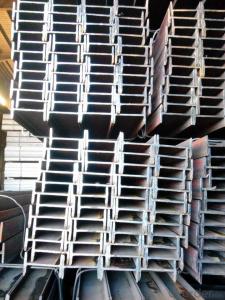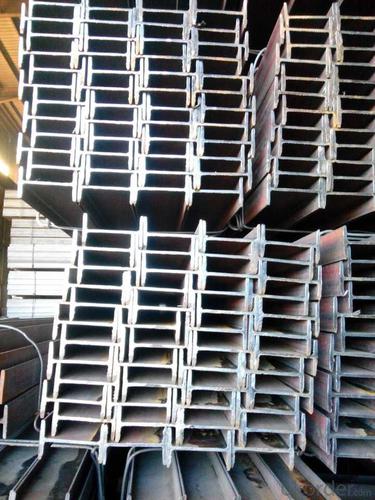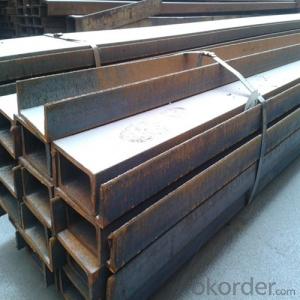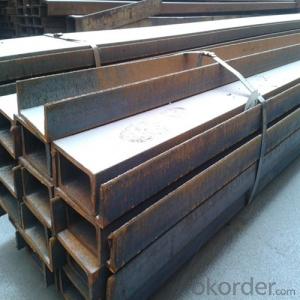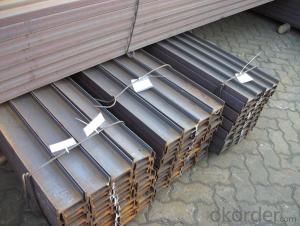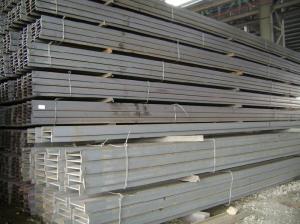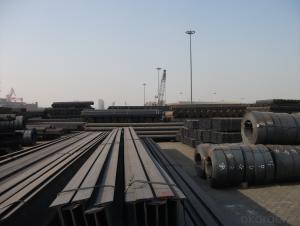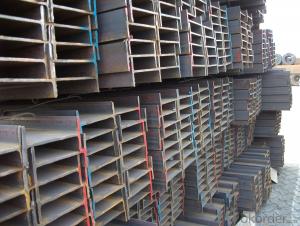European Standard of IPE Beam
- Loading Port:
- China Main Port
- Payment Terms:
- TT or LC
- Min Order Qty:
- -
- Supply Capability:
- -
OKorder Service Pledge
OKorder Financial Service
You Might Also Like
Product Description:
OKorder is offering European Standard of IPE Beam at great prices with worldwide shipping. Our supplier is a world-class manufacturer of steel, with our products utilized the world over. OKorder annually supplies products to European, North American and Asian markets. We provide quotations within 24 hours of receiving an inquiry and guarantee competitive prices.
Product Applications:
IPE/IPEAA Beam Steel are widely used in various construction structures, bridges, autos, brackets, mechanisms and so on.
Product Advantages:
OKorder's European Standard of IPE Beam are durable, strong, and resist corrosion.
Main Product Features:
· Premium quality
· Prompt delivery & seaworthy packing (30 days after receiving deposit)
· Corrosion resistance
· Can be recycled and reused
· Mill test certification
· Professional Service
· Competitive pricing
Product Specifications:
1. Product name: IPE/IPEAA Beam Steel
2. Standard: EN10025, GB Standard, ASTM, JIS etc.
3. Grade: Q235B, A36, S235JR, Q345, SS400 or other equivalent.
4. Length: 5.8M, 6M, 9M, 10M, 12M or as your requirements
<IMG title=IPE/IPEAA style="BORDER-RIGHT: 0px; BORDER-TOP: 0px; MAX-WIDTH: 900px; BORDER-LEFT: 0px; WIDTH: 250px; BORDER-BOTTOM: 0px; HEIGHT: 280px" alt=IPE/IPEAA src="https://file2.okorder.com/prod/2013/11/27/dd95d6a918d1d967216a4cdfdde0000b.jpg" _src="https://file2.okorder.com/prod/2013/11/27/dd95d6a918d1d967216a4cdfdde0000b.jpg">
Section | Standard Sectional Dimensions(mm) | ||||
h | b | s | t | Mass Kg/m | |
IPE80 | 80 | 46 | 3.80 | 5.20 | 6.00 |
IPE100 | 100 | 55 | 4.10 | 5.70 | 8.10 |
IPE120 | 120 | 64 | 4.80 | 6.30 | 10.40 |
IPE140 | 140 | 73 | 4.70 | 6.90 | 12.90 |
IPE160 | 160 | 82 | 5.00 | 7.40 | 15.80 |
IPE180 | 180 | 91 | 5.30 | 8.00 | 18.80 |
IPE200 | 200 | 100 | 5.60 | 8.50 | 22.40 |
IPE220 | 220 | 110 | 5.90 | 9.20 | 26.20 |
IPE240 | 240 | 120 | 6.20 | 9.80 | 30.70 |
IPE270 | 270 | 135 | 6.60 | 10.20 | 36.10 |
<IMG title=IPE/IPEAA style="BORDER-RIGHT: 0px; BORDER-TOP: 0px; MAX-WIDTH: 900px; BORDER-LEFT: 0px; WIDTH: 600px; BORDER-BOTTOM: 0px; HEIGHT: 450px" alt=IPE/IPEAA src="https://file2.okorder.com/prod/2013/11/27/aaec1e0732914ca5c03da5b7c5aa68bb.jpg" _src="https://file2.okorder.com/prod/2013/11/27/aaec1e0732914ca5c03da5b7c5aa68bb.jpg">
Packing & Delivery Terms of IPE/IPEAA Beam Steel
1. Package: All the IPE/IPEAA Beam Steel will be tired by wire rod in bundles
2. Bundle weight: not more than 3.5MT for bulk vessel; less than 3 MT for container load
3. Marks:
Color marking: There will be color marking on both end of the bundle for the cargo delivered by bulk vessel. That makes it easily to distinguish at the destination port.
Tag mark: there will be tag mark tied up on the bundles. The information usually including supplier logo and name, product name, made in China, shipping marks and other information request by the customer.
If loading by container the marking is not needed, but we will prepare it as customer request.
4. Shipment: In containers or in bulk cargo

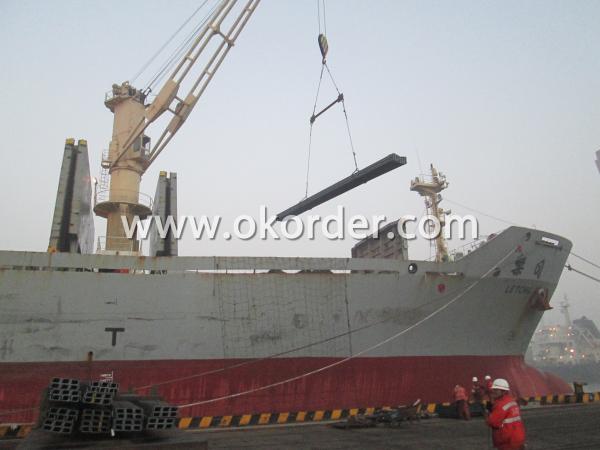
5. Delivery time: All the IPE Beam Steel will be at the port of the shipment within 45 days after receiving the L/C at sight ot the advance pyment.
6. Payment: L/C at sight; 30% advance payment before production, 70% before shipment by T/T, etc.
FAQ:
Q1: Why buy Materials & Equipment from OKorder.com?
A1: All products offered byOKorder.com are carefully selected from China's most reliable manufacturing enterprises. Through its ISO certifications, OKorder.com adheres to the highest standards and a commitment to supply chain safety and customer satisfaction.
Q2: How do we guarantee the quality of our products?
A2: We have established an advanced quality management system which conducts strict quality tests at every step, from raw materials to the final product. At the same time, we provide extensive follow-up service assurances as required.
Q3: How soon can we receive the product after purchase?
A3: Within three days of placing an order, we will begin production. The specific shipping date is dependent upon international and government factors, but is typically 7 to 10 workdays.
- Q: The difference between I-beam i40a and i40b
- Both legs vary widely in width and waist. The leg width and waist thickness of i40a were 142 and 10.5 respectively, and the leg width and waist thickness of i40b were 144 and 12.5 respectively.
- Q: Can steel I-beams be used for seismic retrofitting of existing structures?
- Yes, steel I-beams can be used for seismic retrofitting of existing structures. Steel I-beams are commonly used in retrofitting applications due to their high strength, ductility, and ability to dissipate seismic forces. They can be installed as additional bracing elements, strengthening the structure's resistance against seismic activity and improving its overall stability.
- Q: Can steel I-beams be used for bridge construction?
- Yes, steel I-beams can be used for bridge construction. Steel I-beams are commonly used in bridge construction due to their high strength and durability. They provide excellent load-bearing capabilities, making them suitable for supporting heavy loads such as vehicles and pedestrians. Additionally, steel I-beams are resistant to corrosion and can withstand harsh weather conditions, making them ideal for building bridges that need to withstand various environmental factors. The versatility of steel I-beams allows engineers to design bridges of various spans and shapes, making them a popular choice in modern bridge construction. Overall, steel I-beams are a reliable and efficient choice for bridge construction.
- Q: Are steel I-beams resistant to corrosion?
- Indeed, steel I-beams exhibit exceptional resistance against corrosion. Typically crafted from carbon steel, these beams contain a substantial amount of carbon alongside other elements that heighten their resistance against corrosion. In addition, an extra layer of protection can be applied to steel I-beams through techniques like galvanization or painting. These treatments create a barrier between the steel's surface and its surroundings, effectively preventing direct contact with moisture and other corrosive elements. Consequently, steel I-beams are frequently employed in construction ventures necessitating corrosion resistance, such as the development of bridges, buildings, and other structures exposed to harsh environmental conditions.
- Q: Can steel I-beams be used in curved or arched structures?
- Curved or arched structures can indeed utilize steel I-beams. Although I-beams are commonly employed in straight and linear applications, they can also be curved or arched to meet the design requirements of a structure. This technique, referred to as cold bending or cold rolling, involves shaping the beam into the desired curve or arch while maintaining its structural integrity. This adaptability enables steel I-beams to be incorporated into various architectural designs, such as curved roofs, arched bridges, and curved facades. However, it is crucial to adhere to the manufacturer's specified limits for the degree of curvature or arch to ensure the beam's load-bearing capacity and safety.
- Q: Can steel I-beams be used in stadium construction?
- Yes, steel I-beams can be used in stadium construction. In fact, steel I-beams are commonly used in the construction of stadiums due to their strength and versatility. They provide structural support and can withstand heavy loads, making them ideal for large-scale projects like stadiums. Additionally, steel I-beams can be customized and fabricated to meet the specific design and architectural requirements of the stadium, ensuring a safe and efficient construction process.
- Q: Can steel I-beams be used in modular construction?
- Yes, steel I-beams can be used in modular construction. They provide a strong structural support system and can be easily integrated into modular building designs.
- Q: How about 5 tons of crane rail fixed on I-steel
- First, the pressure plate shall be punched on i-beam. Second the guide rail is screwed with a hook screw and third is welded directly with the welding pressure plate
- Q: What are the design considerations for using steel I-beams?
- When using steel I-beams for structural design, there are several important considerations to keep in mind. 1. Load-bearing capacity: One of the primary factors to consider is the load-bearing capacity of the steel I-beams. The beams must be able to support the anticipated loads, including dead loads (the weight of the structure itself) and live loads (the weight of people, furniture, and other items). The size, shape, and material properties of the I-beams should be chosen to ensure sufficient strength to support these loads without excessive deflection or failure. 2. Span length and spacing: The span length and spacing between I-beams are critical considerations in structural design. Longer spans require larger and stronger beams to prevent excessive deflection. The spacing between the beams should be determined based on the anticipated loads and the required stiffness of the structure. Properly spacing the I-beams is essential to distribute the loads evenly and ensure the structural integrity of the building or bridge. 3. Connection details: The connection details between the steel I-beams and other structural elements are crucial for the overall stability and strength of the design. Welding, bolting, or a combination of both can be used to connect the beams to columns, foundations, or other supporting elements. The connection design should consider factors such as load transfer, shear and moment resistance, and compatibility with the surrounding materials. 4. Fire resistance: Steel is a non-combustible material, but it can lose its strength when exposed to high temperatures. Therefore, fire protection measures should be considered when using steel I-beams in buildings. Methods like fire-rated insulation, intumescent coatings, or encasement with fire-resistant materials can be employed to enhance the fire resistance of the steel beams and maintain their structural integrity in case of fire. 5. Cost and availability: The cost and availability of steel I-beams should also be considered in the design process. The size, grade, and fabrication requirements of the beams can affect their cost. Availability can be influenced by factors such as local steel suppliers, manufacturing lead times, and transportation logistics. Balancing the desired design with cost-efficiency and accessibility is an important consideration for any project. In conclusion, the design considerations for using steel I-beams involve assessing load-bearing capacity, span length and spacing, connection details, fire resistance, and cost and availability. It is crucial to carefully evaluate these factors to ensure a safe and structurally sound design using steel I-beams.
- Q: How do steel I-beams perform in terms of fatigue resistance?
- Steel I-beams have excellent fatigue resistance properties. The design and construction of I-beams make them highly resistant to fatigue failure, which is the gradual weakening and eventual failure of a material under repeated cyclic loading. The structural shape of I-beams, with the flanges providing resistance to bending and the web resisting shear forces, helps distribute the load evenly across the beam. This balanced load distribution minimizes stress concentrations and prevents the build-up of fatigue cracks. Moreover, steel itself is known for its high fatigue strength. It can withstand a large number of load cycles before failure, making it an ideal material for applications where fatigue resistance is crucial. Steel I-beams are commonly used in various structural applications, such as bridges, buildings, and industrial facilities, where they are subjected to repeated and fluctuating loads. The fatigue resistance of steel I-beams ensures their long-term structural integrity and safety under these demanding conditions. In addition, the fatigue performance of steel I-beams can be enhanced through various techniques, such as surface treatments and welding details. These methods aim to improve the fatigue life and durability of the beams by reducing stress concentrations and increasing their resistance to crack initiation and propagation. Overall, steel I-beams exhibit exceptional fatigue resistance, making them a reliable choice for structures that require long-term durability and safety. Their ability to withstand cyclic loading and resist fatigue failure makes them ideal for applications where repeated or fluctuating loads are expected.
Send your message to us
European Standard of IPE Beam
- Loading Port:
- China Main Port
- Payment Terms:
- TT or LC
- Min Order Qty:
- -
- Supply Capability:
- -
OKorder Service Pledge
OKorder Financial Service
Similar products
Hot products
Hot Searches
Related keywords
